After my last, slightly controversial, post it’s time to get back to a fun post! My Basic D&D campaign is starting on August 31st and I am still deep in preparation for that game. I’m working on my guide for the developing Eleven Pillars setting, and this week I will give you a look at the major deities of the Mountainlands. Remember that during the Great Migration, when the civilized folks were moving up to the Mountainlands, they failed to find the large palaces they expected would be inhabited by gods (a la Mount Olympus), causing a new religion to take hold. The Old Religion is still acknowledged in more subtle ways (e.g. several of the months are named after the old gods or their exploits, just as on Earth today). I’ll talk about the Gods of the Old Religion in a later post, but for now, here is the Pantheon of the New Religion.
Pantheistic Tendencies
The civilized people of the Eleven Pillars live in a pantheistic society. They worship the gods hoping to garner favor, luck, or prosperity by pleasing as many gods and goddesses as they can. They do not believe in gods who come down and take a mortal form, but they do believe that the gods have a hand in the fates of mortals (if the god so chooses), and they believe in divine intervention. Here are the 7 primary gods of the pantheon and three specific gods of the demi-human races. You will note that many of them have influences over agriculture and growth because that was the most pressing concern when the civilized people moved up into the Mountainlands during the Great Migration – they needed patron deities that would provide them with food and shelter and allow their populations to grow.
Sedna, Lord of the Mountains
Alignment: Lawful Good 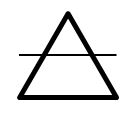
Symbol: A triangle with a horizontal line about 1/4 the way down (represents the cloudline)
Sedna is the God of the Earth, Giver of Knowledge, Arbiter of Civilization, Bringer of Wealth, and Bastion of Strength. He is worshiped by all as chief god, and when people feel wronged or ignored by other gods, they look to Sedna to grant them redemption in the eyes of the other gods. Temples to Sedna often feature ceremonies that include passing around dirt that has been blessed by the priests and represents the power of Sedna over the earth.
Abiel, Goddess of Thunder
Alignment: Neutral 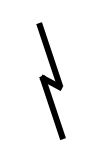
Symbol: A lightning bolt
Abiel is the Goddess in charge of the Weather, and any time there is an unusually hot day, the people pray that she brings rain after the sun so that the crops will grow. She also holds sway over Time, the Luck of the Stars, the Moon, and Natural Change. Agricultural bounty, mild seasons, full lakes, the birth and death of food animals are all under the purview of Abiel. Temples to Abiel are the only ones which are often built outside of the Pillar. They are open air buildings with lots of columns carved into tree shape and no proper roof. The priests and priestesses of Abiel proffer their sermons and ceremonies on a platform in the middle of the structure. If a storm begins in the middle of the rites, the priest or priestess must stay in the temple until the storm passes completely.
Kusti, God of Anger
Alignment: Lawful Evil 
Symbol: A rectangle split into three equal parts, the middle one darkened, but with a hole in it
Kusti is the Lord of Agony, Sower of Death, and Sire of Suffering. He is the source of all disease, tyranny, and destruction. In practice, Kusti is simply the scapegoat for all the ills in the world perceived by the people. You sustain an injury, Kusti is taunting you. You fall ill with an unknown sickness, Kusti is meting out his justice on you. The response of the populace ranges from the afflicted ones being so good that Kusti must punish them to the afflicted ones deserving it for their poor behavior. There are no open temples to Kusti, but rumors abound that one of the pillars contains a true temple to the Lord of Agony and it is a dark and dirty place filled with the bones of the sacrificed. Of course, wherever you hear this, it is always a different pillar that has such a vile place. Kusti is said to be worshipped by the minions of the dark and ignorant creatures of the world, especially those that employ methods such as kidnapping, slaving, ambushing, and nasty trickery.
Lanno, Lady of Scales
Alignment: Chaotic Good 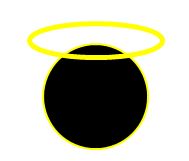
Symbol: A circle with a halo (sun shaped)
Lanno is the master of knowledge and finding peace in knowing all things. She is revered by those who delight in knowledge for knowledge’s sake; especially in history, including mystical arcana, religious history, as well as natural history and ecology. The origins, rites, and ceremonies of most of the deities of the new religion can be traced fairly easily, but that is not the case with Lanno. Her moniker, Lady of Scales, can be interpreted multiple ways and she is sometimes shown with a set of scales, and other times shown as having scales on her body. Many believe that Lanno is responsible for the arcane power of the world, she draws the power from fate itself, and that without Lanno, there would be no arcane power. Ceremonies always include arcane magic and the priests are skilled mages.
Fazl, Lord of Lakes
Alignment: Neutral Good 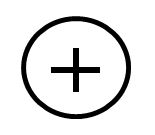
Symbol: A circle with a plus sign in the middle
In an effort to feed and protect the inhabitants of the Mountainlands, Fazl created lakes high in the mountains. He is said to be a powerful combatant, to have no patience for disobedience, and to punish those that do not adhere (in their heart of hearts) to the laws that he has set – punishable by crop failure and sickness. He is revered by all manner of fishermen, farmers, and herders, and well as dock-workers, ship-builders, navigators, and astronomers. He offers his followers abundance, open lakes, freedom, and protection from natural beasts. Rites at the Temple of Fazl are often feasts that include fish and root vegetables. Fish eggs are sacred, along with young animals, which are never to be hunted or eaten.
Matfey, Lord of Growth
Alignment: Neutral Good 
Symbol: A sapling growing out of an anvil
If Fazl is the punishing god of mountain lakes, Matfey is the benevolent god of mountain fields. He looks after the crops and brings forth new growth from planted seeds. He is the Bringer of Life, Creator of Plants, and Lover of Hope. He is also the patron god of creators, such as carpenters, wainwrights, blacksmiths, and artists, along with other craftsmen. In the first few decades after the Great Migration, Matfey rose to prominence as one of the most important gods as he was responsible for the growth of crops necessary to feed the beleaguered populace. The ceremonies of Matfey include a promise to plant new trees and crops to replenish the supply.
Ness, Sealer of Deals
Alignment: Chaotic Neutral 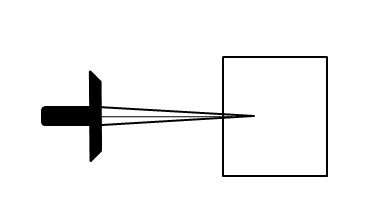
Symbol: A square with a dagger sticking into the side from the left
Ness is a lover of risk and excess. He thrives where temptation leads one to commit acts of high risk. He is the patron god of gamblers and traders, and possibly has the largest following as he is looked to for protection by potion-makers, inventors, assassins, shopkeepers, tavern masters, merchants, and traveling caravaneers. Anything with risk and reward involved is a magnet for followers of Ness. He is also embraced by thieves’ guilds, corrupt politicians and royalty, and whimsical jesters.
Hyrker, Patron Goddess of Halflings
Alignment: Neutral
Symbol: A coin with a box, a barrel, and a mug
Hyrker is the Keeper of the Small Ones, Breaker of Bread, and Purveyor of Luck for the Halfling race. She is known to help out a needy Halfling in a pinch, but sometimes exacts a harsh repayment. She is thus worshipped in earnest and with great faith, but she is also feared.
Eord, Patron God of the Elves
Alignment: Lawful Good
Symbol: A sheep in silhouette
Eord (pronounced yerd) is the ancient, genderless god of the forest. Eord is not only the patron of Elves, but is also worshipped by trackers, traders, hunters, nature lovers, many farmers that hold livestock, and animal trainers. There is a large break in the Elvish community caused by new interpretations of the Will of Eord. A large portion of the population believes that Eord wants the Elves to reclaim their ancient homelands by traveling into the Lowerlands and settling in the forests there.
Fallow, Patron God of the Dwarves
Alignment: Neutral
Symbol: An anvil with flames behind it
The Dwarves maintain that Fallow is the All-Father, the God of Gods, and the progenitor of all civilized life. They believe Dwarves to be the oldest race, and therefore the true leaders of the races. This teaching was bolstered when the Great Migration brought everyone up to the mountains, the Dwarves ancestral birthplace. The Dwarves are skilled miners, tinkers, armor-smiths, blacksmiths, engineers, builders, jewelers, jewelry-makers, and traders. They are rather arrogant and look upon other races as children, often patronizing them even though they respect them a great deal – they do believe in being polite, even to children. Temples to Fallow only allow Dwarves to enter, and so their ceremonies and rites are private.
So there are the Deities of the New Religion. I hope you enjoy reading the development of this setting as much as I enjoy writing it. Next time, I will show you the Coats of Arms of the ruling families of the Eleven Pillars, so lot’s of pictures! Look for that post on Wednesday, it’s already written (and the art is done) and I think you will enjoy it.
Until next time, I wish you good gaming!
~DMSamuel
